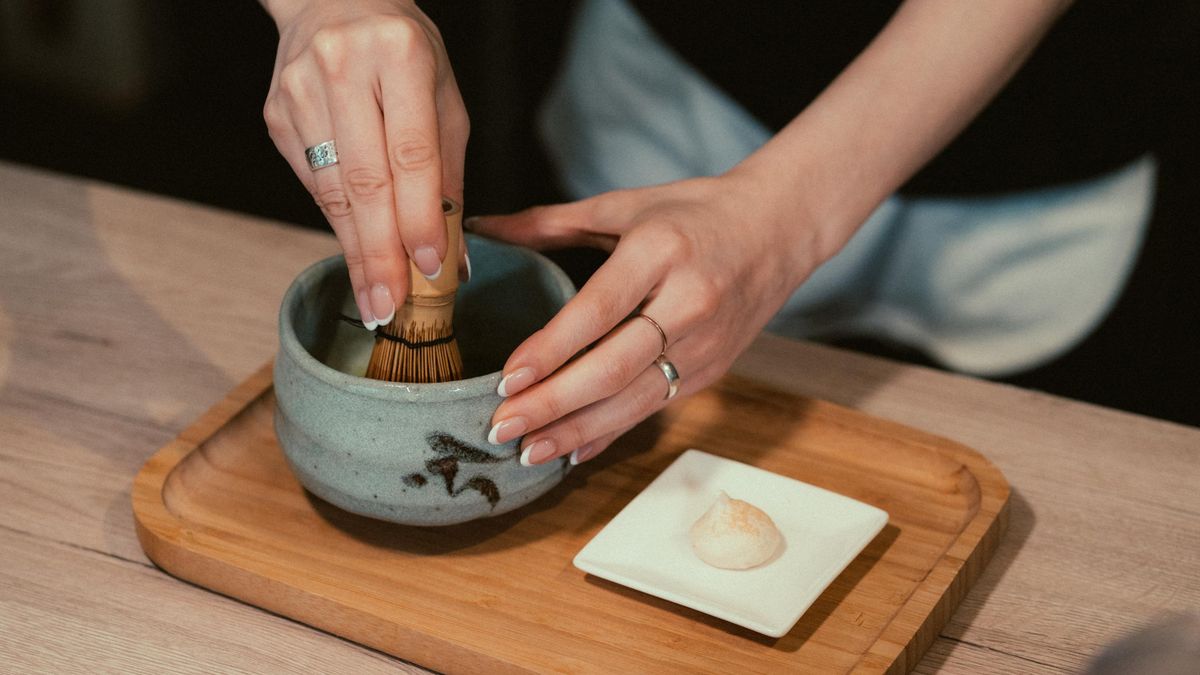Matcha and Longevity Backed by Science and Ritual

When we stood in a tea field in Uji Wazuka for the first time with my wife Anna, surrounded by misty green hills and the scent of steamed tea leaves from the small tea factories, I understood why matcha is more than just another hype. It was one of the moments that inspired us to found Very Matcha and to bring authentic Japanese matcha to more people.
Besides being a ritual born from Zen temples, samurai training grounds and the quiet discipline of Japanese tea masters, matcha represents dedication and craftsmanship that has been perfected over centuries. Today matcha has become a global phenomenon and is considered a healthy alternative to coffee and caffeinated energy drinks.
This article explores matcha as cultural heritage and as a modern beverage its origins, preparation, science backed effects and how to choose high quality powder. As a pharmacist, I take a clear view: matcha is not medicine or a miracle cure. It is a finely crafted food with unique properties and certain health benefits, best enjoyed with knowledge and respect.
“When you hear the splash of the water drops that fall into the stone bowl, you will feel that all the dust of your mind is washed away.”
Sen no Rikyu, Japanese tea master 1522 to 1591
From Zen temples to barista counters
Matcha’s roots go back more than 800 years. Zen monks in Japan adopted simple powdered tea from China and transformed it into a disciplined practice covering everything from cultivation and processing to preparation and the outer and inner rituals of drinking matcha. Samurai used matcha for mental clarity before combat, and shoguns and emperors served it during political negotiations. The tea ceremony chanoyu codified these rituals, blending aesthetics, mindfulness and hospitality.
This heritage still matters today. When we prepare matcha traditionally as usucha thin tea or koicha thick tea, we are not just whisking green powder. We are participating in a centuries old mindfulness exercise. Even a modern matcha latte can carry some of that calm energy if we know what is in our bowl.
Matcha vs plain green tea powder
Not every green powder sold as matcha is authentic. True matcha meets three criteria:
- Shade grown for several weeks before harvest, boosting chlorophyll, L theanine and umami
- Milled from tencha, only the soft leaf tissue, with bitter stems removed
- Ground slowly on granite stone mills for an ultrafine texture
Industrial green tea powder, by contrast, is often unshaded, milled whole with stems and tastes bitter or grassy. It lacks the amino acid profile that gives high quality matcha its unique umami flavor and mellow alertness.
A gentle kick from caffeine and L-theanine
Matcha contains about 30 to 35 mg of caffeine per gram, similar to an espresso shot but with a twist. Because matcha is rich in L theanine, a rare amino acid, the stimulant effect is smoother and longer. Studies show that caffeine combined with L theanine improves focus, reaction time and working memory more than caffeine alone. Instead of a spike and crash, you get calm alertness, ideal for creative work, long study sessions or simply feeling balanced through the afternoon.
Beyond caffeine catechins chlorophyll and micronutrients
Matcha’s vibrant green color reflects its high chlorophyll content. As a whole leaf powder it also delivers more catechins, especially EGCG, than a typical green tea infusion. Catechins are plant polyphenols with well studied antioxidant properties. Meta analyses link green tea consumption to modest improvements in weight maintenance, LDL cholesterol and blood pressure, but the effects are moderate, not miraculous.
Matcha also provides small amounts of vitamins A as beta carotene, C, E and K. However, because a typical serving is just 1 to 2 g of powder, these micronutrients contribute to your diet but are not major sources on their own.
Longevity & matcha
Japan consistently ranks among the countries with the highest life expectancy in the world. In Okinawa and other so-called “blue zones” it is common to see people living well into their 90s, 100s and beyond. While diet, social cohesion and lifestyle all play a role, one constant in Japanese culture is green tea. Green tea is consumed daily in homes, workplaces and ceremonies. Matcha, as the most concentrated form of green tea, brings together several compounds that have been linked to longevity pathways.
- Polyphenols such as EGCG and related catechins: Laboratory and animal studies suggest these compounds act as antioxidants, reduce chronic inflammation, support DNA repair and modulate signaling pathways associated with aging, including SIRT1, FOXO and AMPK. In simple organisms like C. elegans, green tea catechins have extended lifespan and increased stress resistance.
- Autophagy and cellular housekeeping: Recent research hints that green tea polyphenols may encourage autophagy, the process by which cells recycle damaged proteins and organelles, which is considered one of the hallmarks of healthy aging.
- Brain and cognitive health: Large Japanese cohort studies have found that higher green tea consumption is associated with lower risk of cognitive decline. The combined effects of caffeine, catechins and L-theanine may support attention, memory and neuroprotection.
- Epidemiological data on mortality: Several prospective studies in Japan report that people who drink multiple cups of green tea daily have a lower risk of cardiovascular disease and overall mortality compared with those who drink little or none.
These findings are associations rather than proof of causality, and the doses used in lab experiments are often much higher than a typical bowl of matcha. Still, they provide plausible mechanisms by which long-term matcha consumption could fit into a lifestyle aimed at healthy aging and longevity. Not as a magic bullet, but as part of a broader pattern of nutrition, community and mindful living.
Sustainability matters
Japanese matcha, especially organic matcha, has been grown and harvested in harmony with nature for centuries. A famous example is the traditional Chagusaba tea grass method, a farming practice recognized in 2013 by the Food and Agriculture Organization of the United Nations as a Globally Important Agricultural Heritage System. This approach enriches biodiversity, protects soils and preserves local knowledge.
Packaging also makes a difference. A typical aluminum tin holding 30 g of matcha can weigh over 40 g itself, meaning more than 60 percent is packaging weight rather than tea. Because matcha is imported by air, every gram counts. Imagine a plane transporting more than 60% waste. Refills and zip lock pouches drastically reduce packaging weight and volume, leading to lower emissions and less waste. At Very Matcha we use lightweight packaging when importing from Japan, which also reduces cargo costs significantly and lets us focus on matcha quality instead. Choosing sustainable packaging is one of the simplest ways to enjoy matcha with a lighter footprint.
What about aluminum iron and hair loss
Because you ingest the whole leaf, matcha can contain more of certain natural elements than brewed tea. Aluminum is one of them. Tea plants absorb it from the soil. Analyses show wide variation among matcha brands, some with very low levels, some surprisingly high. The German Federal Institute for Risk Assessment advises paying attention to quality and origin, as excessive aluminum intake over time can stress the body. Reputable brands test their batches and can provide certificates.
Polyphenols in tea can also temporarily reduce the absorption of non heme iron from plant foods. In practice, one or two bowls of matcha per day with a balanced diet are unlikely to cause iron deficiency. If you are vegan or have low ferritin levels, simply enjoy your matcha between meals rather than with iron rich foods.
As for hair loss, despite viral posts on social media, no clinical trial shows matcha causes or prevents hair loss. Lab studies hint that EGCG might even protect hair follicles by moderating DHT pathways, but this is early stage science, interesting yet far from proof.
Matcha as a coffee and energy drink alternative
For consumers seeking a smoother lift, matcha offers:
- Comparable caffeine but steadier energy thanks to L theanine
- Lower acidity than coffee, often gentler on the stomach
- Versatility hot or iced, dairy or plant milk, plain or with creative flavors
For café owners, matcha broadens the menu beyond espresso and cold brew, appealing to customers who want novelty, plant based options or a wellness oriented vibe.
How to choose high quality matcha
Because ceremonial grade is not legally defined, you need to look beyond marketing terms. Key quality indicators:
- Origin Japan, ideally from renowned regions such as Uji, Kagoshima or Shizuoka
- Shade growing at least 2 to 4 weeks before harvest
- Tencha processing stems removed, steamed not roasted
- Stone milling ultrafine texture about 5 to 10 microns
- Color vibrant jade green, not dull or yellowish
- Aroma sweet, oceanic, umami rich, not fishy or metallic
- Lab testing for pesticides and heavy metals
As a rule of thumb, if a matcha is very cheap, it is probably not real matcha.
Preparing matcha tradition and modern hacks
The classic way is to sift 2 g matcha into a warm bowl, add about 60 ml water at 70 to 80 °C, then whisk briskly with a bamboo chasen until a fine foam forms. This produces usucha, a smooth and vibrant tea. For koicha, use triple the powder and less water for a rich, syrupy texture.
For a café style matcha latte, prepare a concentrated matcha shot first, then add steamed milk or plant milk. A quick home hack is to shake matcha and water in a jar, froth your milk separately, then combine.
Safety and special populations
Matcha is generally safe. Its caffeine content is similar to coffee, so pregnant or breastfeeding individuals and people sensitive to caffeine should limit intake. People on anticoagulants or certain heart medications should also check with their healthcare provider, because matcha contains vitamin K and bioactive compounds that may interact with medication.
The European Food Safety Authority considers traditional green tea beverages safe, but warns that very high doses of green tea extracts such as supplements providing 800 mg EGCG per day can in rare cases affect liver enzymes. A few bowls of matcha daily come nowhere near these levels.
The take home message
Matcha is best understood as a culinary craft, shade grown, stone milled leaves that deliver a calm, focused energy and a link to centuries of Japanese culture. It is not a cure all, but it is more than a trend. For consumers, it is a mindful beverage experience. For café owners, it is a way to offer something authentic, sustainable and scientifically grounded.
When you choose high quality matcha and prepare it properly, you are not just making a drink, you are practicing a small ritual that connects past and present, science and taste, focus and calm.
References
Author: Jochen Meyer
Jochen is the co-founder of Very Matcha. He earned his degree in pharmacy (PharmD) at FAU Erlangen and conducted Alzheimer’s research at the University of Florida. Jochen is into sports, nutrition and longevity and is passionate about green tea and Japanese matcha. Having practiced judo as a child, he draws inspiration from Japanese culture to build a truly sustainable brand for authentic organic matcha, sourcing directly from Japanese family businesses.




